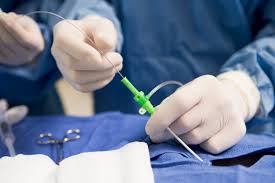Comparing Lubricious Coatings
Posted by Sean Horn
Friday, December 23, 2016 7:47
@ 7:47 AM
Selection of the material used to coat a medical device is very influenced by the operational environment it will encounter when implanted in the body. Pertinent operational/performance factors typically include:
- Chemical, electrical and mechanical compatibility of the coating material with the medical device it is intended to cover.
- The internal conditions affecting the device’s function, factors such as bodily fluids, chemicals, and moisture.
- Temperature variation the device is expected to encounter.
Equally important in many cases is lubricity, a coating’s ability to reduce component friction or wear, during use. 
As a property of conformal coating, lubricity is expressed by the value of its coefficient of friction, which offers a numeric description of how slippery a surface is; lower values indicate lower frictional resistance. Lubricity is an important consideration in the design, installation and function of disposable medical appliances like cardiac-assist devices (CADs), catheters, guidewires, or stents. For them,
- higher-level surface lubricity can substantially reduce the insertion-force required for successful implant,
- while permitting easier navigation throughout the patient’s vascular or other internal structure,
- significantly reducing the potential of puncture damage or severe abrasion generated between the device surface and the vessel walls.
Good lubricious coatings generally demonstrate a reduction in frictional forces exceeding 90% of that of an uncoated device. In addition, they maintain that level of lubricity for an extended operational period, and are thus essential for specialized medical applications.
Hydrophilic and Hydrophobic Coatings
Lubricity of conformal films is achieved by application of low-friction materials on the matrix surface of implantable medical devices, to limit tissue damage and enhance access to the targeted treatment site within the body. Friction reduction by coatings can be achieved by either wet hydrophilic or dry hydrophobic means.
Hydrophilic coatings also include combinations of hydroxyethyl methacrylate, polyethylene oxide, or polyvinylpyrrolidone (PVP), among other substances. Despite their material diversity, they are all hydrophilic,
- sharing the capacity for accumulating and collecting water
- in the polymeric backbone placed on the device surface.
Most hydrophilic coatings are applied by dipping or spraying the film substance onto the device. They also possess the additional benefit of diminishing the incidence of thrombosis when a catheter or guidewire is used. Unfortunately, many of materials are not entirely safe for patients because their lubricious function can diminish over time, dissociating or dissolving away from the matrix surface, leaving particulates in tissue or the bloodstream.
Hydrophobic conformal coatings provide dry-film lubricity, and include such materials as parylene and liquid Teflon (PTFE). Applied by wet methods, PTFE has a lower co efficient of friction than parylene. However, parylene can offer better quality dry-film lubricity in many cases, essentially because of its chemical vapor deposition (CVD) application process, which provides a generally more resilient and pinhole-free protective film.
The Relevance of a Material’s Coefficient of Surface Friction
Frequently designated by the Greek letter µ, the coefficient of friction measures of the quantity of resistance a surface exerts on substances moving across it. A lower coefficient value is desirable, since it indicates lesser friction; much depends on the materials comprising the touching surfaces.
Lubricated surfaces have lower levels of friction. The ideal coefficient of friction for hydrophilically-coated medical devices ranges between 0.01 to 0.1, about the same as ice and often difficult to achieve. Optimally, medical hydrophilic coatings can be applied to a wide range of polymeric and metallic substrates, providing suitable lubricity and biocompatibility, with necessary levels of abrasion resistance and non-thrombogenic properties.
Dry hydrophobic coatings for medical products have higher coefficients of friction, ranging from 0.2 to 0.3 for Teflon, to 0.25 – 0.4 for parylene. In addition to improving components’ lubricity, parylene films also reduce overall surface tack, with micron-thin biocompatible coating protection, generating outstanding chemical, dielectric barrier and moisture protection for an exceptional range of medical devices and components. These parylene coatings provide sufficient dry-film lubricity to lubricate implanted medical devices per specification without compromising the devices’ original elasticity.
Selecting the Appropriate Conformal Coating
The advantages of hydrophilic coatings are somewhat compromised by a tendency to generate particulates over time, which can become embedded in tissues or the bloodstream. Hydrophobic parylene is a comparatively soft polymer that seldom flakes or dissociates during use, making it a superior option in cases where development of particulate is a concern.
As always, the final selection of a coating material is reliant on the specific medical application and environmental conditions after implant. Hydrophobic parylene offers a superior option for improved lubricity for metal substrates, selected elastomers like silicone rubber, tubing and wire. Parylene can significantly reduce surface stickiness to one that is even, smooth, without risk of particulates. Its use is suggested in all cases where hydrophilic coatings are not advised.
To learn more about medical devices and conformal coatings, download our whitepaper:
The Truth about Medical Devices and Parylene
Comments
Homepage 4/17/2020. 10:17:10 AM
... [Trackback] [...] Informations on that Topic: blog.paryleneconformalcoating.com/whats-the-difference-between-potting-and-conformal-coating/ [...]

londondrugscanada.bigcartel.comlondon-drugs 4/17/2020. 10:17:10 AM
cialis uk https://londondrugscanada.bigcartel.com/london-drugs This is nicely expressed. !